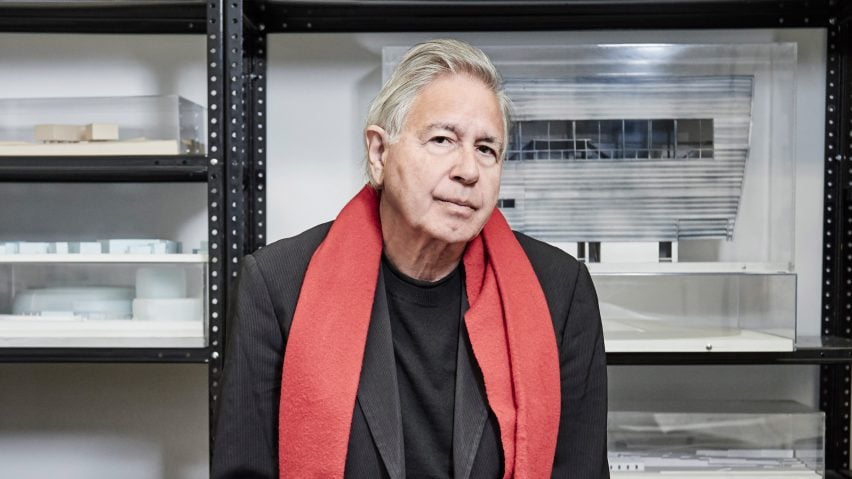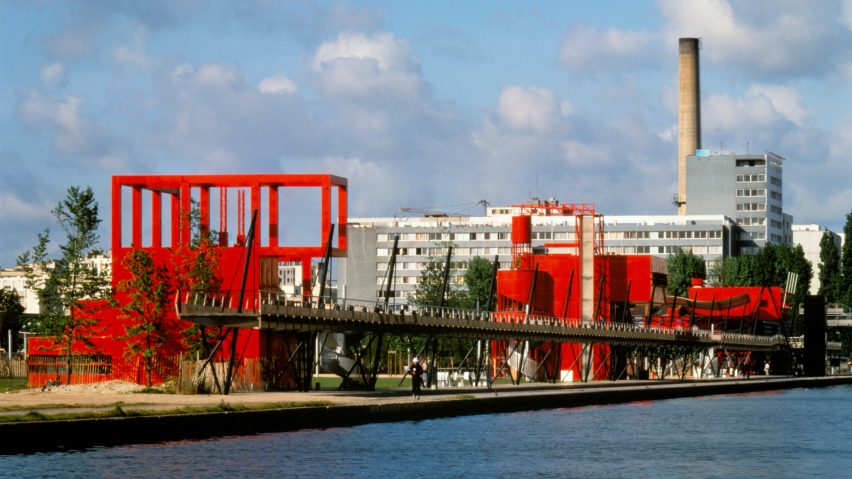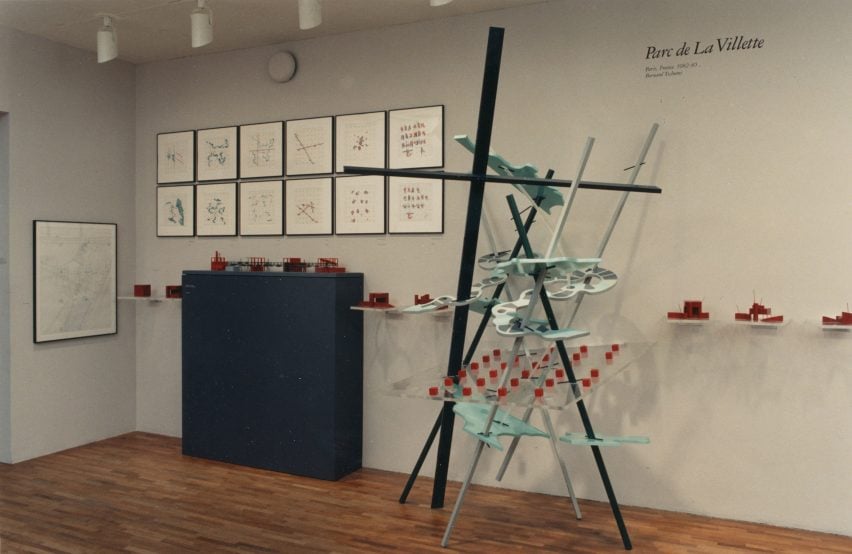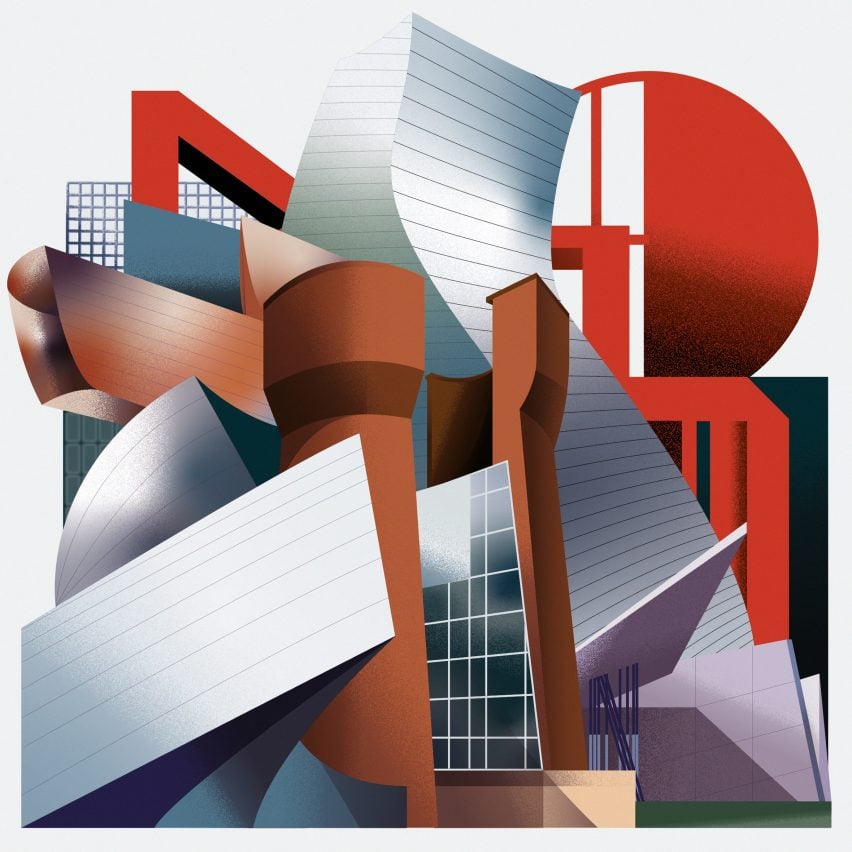
The legacy of deconstructivism "makes me want to retreat to the back of the room" says Bernard Tschumi
Deconstructivism was built on intellectual rigour and a desire for exploration that contemporary architects do not share, says French-Swiss architect Bernard Tschumi in this exclusive interview as part of our series on the style.
According to Tschumi, who was one of the seven architects featured in the seminal Deconstructivist Architecture show at the Museum of Modern Art (MoMA), deconstructivism had a serious intellectual ideology that was developed by young architects reinvestigating avant-garde architecture from the 1920s.
"Architecture was under pressure to justify itself"
"The younger generation, very much based around the AA in London, were not interested in either neo-modernism or postmodernism – because they felt it was a tired discourse," Tschumi told Dezeen.
"We explored things in an intuitive and spontaneous manner. We had something in common, an interest in early 20th-century avant-garde," he continued.
"Not the official modernism, but surrealism, futurism, constructivism and expressionism in cinema. We felt that there was still something that had not been fully explored."
Tschumi, alongside Peter Eisenman, Frank Gehry, Zaha Hadid, Rem Koolhaas, Daniel Libeskind and Wolf Prix, was part of a group exploring these ideas by asking questions about established forms of architecture.
"[At that time] architecture was under pressure to justify itself and to renew itself," said Tschumi.
"That took place through a whole series of questions: What is a programme? What is an event? What is an envelope? What is movement in space? And so on. And that questioning, for me, was the most important thing about let's call it deconstructivism."

This interest in theoretical architecture led to the group becoming known as "paper architects" but, according to Tschumi, a series of open competitions led to them being able to actually realise some of their ideas.
"By the end of the 70s/early 80s, all of us had quite a recognisable portfolio of work, and we were called paper architects," he explained. "Then something unusual happened – a few places, in particular in Europe, organised major open competitions."
"And it was just the right moment for people like us to say: 'Hey what we tested and played with, how about testing them with a real programme, not the one that we wrote ourselves, but the narrative provided by somebody else'," he continued.
"The timing of these large competitions was incredibly positive. Although we didn't have the experience and we would never have been invited to international competitions, because we had no credentials, what we were doing was fresh and allowed us to win many of those."
"No one in that exhibition ever wanted to be called a deconstructivist architect"
In 1983, Tschumi beat more than 470 entrants to win the prestigious competition to design the Parc de la Villette in Paris while Hadid won an open competition to design The Peak, a private club in Hong Kong.
The drawing and models of both of these projects would be featured in the 1988 Deconstructivist Architecture show at MoMA.

While all the architects in the show "had a lot of respect for one another", according to Tschumi, none of them considered themselves deconstructivists.
"At first, it was not called deconstructivist architecture," he explained. "And little by little, it coalesced into something that people felt, 'ah, it's a new movement'."
"But what is interesting is that none of those seven people ever thought they were part of a movement," he continued.
"They didn't want to be part of a movement, they never called it a school of thoughts, so when you ask me would I ever call myself a deconstructivist architect? No, I never would. No one in that exhibition ever wanted to be called a deconstructivist architect."
This echoes Eisenman's views, who recently told Dezeen in an interview: "I'm very much against deconstructivism. I think it's a sham. I mean, it doesn't exist."
Tschumi believes that while all seven of the architects in the exhibition were working "in different ways" they all based their work on intellectual research.
"So many corporate firms have literally learned too much"
However, according to Tschumi, the generation of architects that followed took the form-making elements of deconstructivism but ignored its intellectual roots.
"When you asked me what was deconstructivism's impact on contemporary architecture – that's where I want to retreat at the back of the room," said Tschumi.
"Because so many corporate firms have literally learned too much, but purely about the image-making part of the deconstructive period."
He cites Norman Foster's recent proposal for a skyscraper in New York and "the architect from Denmark" as people who built on the form-making concepts developed by deconstructivism.
"Right now in New York City, it was in the Dezeen, Norman Foster doing a skyscraper on Park Avenue, that would not have happened without the deconstructivist show," he said.
"You know the architect from Denmark or from Japan, who these days are happily doing things that do this and that."
Asked if he feels that the generation of architects that came after the early deconstructivists borrowed the movement's ideas on form without being interested in its intellectual basis, Tschumi said: "Yes, I agree with that."
Read on for an edited interview with Tschumi:
Tom Ravenscroft: How do you define deconstructivism?
Bernard Tschumi: I'm going to say a lot of cliches about it. It's the contraction between constructivism and deconstruction. And somebody very clever, probably a journalist, decided that it was a good idea to put those two words together.
I'll explain in a minute why constructivism and deconstruction made sense. But the two together may not have made any sense. So the context in which all this happened, it's very important to remember that in the 70s there was a return to some very strong ideological values.
To simplify these were neo modernism versus postmodernism. And both were fairly excessive. You may remember names of course, like [Robert] Venturi and [Aldo] Rossi and a few others on one side, and people who believed in the roots of all the modern movements.
The younger generation, very much based around the AA in London, were not interested in either neo-modernism or postmodernism – because they felt it was a tired discourse.
We explored things in an intuitive and spontaneous manner. We had something in common, an interest in early 20th-century avant-garde. Not the official modernism, but surrealism, futurism, constructivism and expressionism in cinema. We felt that there was still something that had not been fully explored.
There were at least a couple of people who read a little more than the others. People who were more interested in the history of ideas. Eisenman and myself had come across the concept of deconstruction – not only Jacques Derrida, but a lot of French philosophers – [Michel] Foucault and [Roland] Barthes.
The word deconstruction had a special interest for architects. So at that time, we were not talking at all about style. At that time, everybody is testing and exploring. So the work develops fairly independently.
There is also a very important figure in that group, it's Frank Gehry, who is definitely quite another generation, but who had the circumstances of being in California in a place where it seems never to rain, never to snow, and therefore you can build anything that like spontaneously.
So that started to become, not a structured conversation, but a group of people who knew each other – everybody knew one another. But working pretty much on their own in their own direction. I don't think there was that much serious discussions or exchange, it was really a mood.
Tom Ravenscroft: So how did deconstructivism come to be a thing?
Bernard Tschumi: People identified that and people who were pretty smart journalists and pretty smart cultural figures started to think let's have exhibitions, let's show these people. And at one moment MoMA, which of course is a major power, decided that that would be a good idea.
At first, it was not called deconstructivist architecture. And little by little, it coalesced into something that people felt, "ah, it's a new movement". But what is interesting is that none of those seven people ever thought they were part of a movement.
Even they didn't want to be part of a movement. They never called it a school of thought. You asked me, "would I ever call myself a deconstructivist architect?" No, I never would. No one in that exhibition ever wanted to be called a deconstructivist architect.
At the same time, at the same time, something happened, which was very odd, and which, in a sense, gave us a lot of publicity. Some outsiders started to think, Oh, that was interesting, that was new.
A lot of architecture was somehow under pressure to justify itself and to renew itself. And that took place through a whole series of questions, you know: what is a programme? What is an event? What is an envelope? What is movement in space, and so on? And these questions, the mode of questioning, was somehow not so different from the mode of questioning, which was happening in other disciplines. People were asking questions in philosophy, people were asking questions in literature, people were asking questions in law and in everything.
And that questioning, for me, was the most important thing about deconstructivism. The other thing is, I mentioned already was the interest for the early 20th-century avant garde. And you recognise it clearly in the work of every one of us. Every one of that group. And constructivism, which had not gone very far for all sorts of reasons.
Because we were producing questions, but we were also producing images as images were easier to be consumed. And that's when people started to call it slash and crash as a style. And that was really not the issue. But it provided us a lot of mileage,
Tom Ravenscroft: You said none of you seven, wanted to ever be called deconstructivists. But surely you must have known that by signing yourself up to the MoMA exhibition the legacies would be that you would be known as deconstructivists, so you were complicit in the development of the name?
Bernard Tschumi: As you're making your argument, I will not deny it and will not agree directly. But none of us pulled out of the show.
Tom Ravenscroft: So why did you take part in the exhibition?
Bernard Tschumi: All the people in the show had a lot of respect for one another. And we knew what we were doing was different. We were all in our mid to late 30s, except for Peter Eisenman and Frank Gehry, so it was at the beginning when young architects are the most aggressively competitive and we were visa vie one another.
At the same time, we had more sympathy for what we were doing and each other, than the world of Bob Stern. And we were not terribly interested in the reinventing of Richard Rogers, Renzo Piano or Norman Foster. Everybody had a strong position, which was not necessarily the case of the people on the other side.
Tom Ravenscroft: So what you shared was a different way of doing architecture?
Bernard Tschumi: I know that some of my colleagues said that these guys were the only ones doing something interesting at the time. The question is, what kind of questions were raised? In my particular case, I was interested in not only what it looks like, but what it does. In other words, the idea of programme, the idea of events – how architecture could be a generator of activities.
When you do anything that is a little different it creates an incredible amount of energy. I guess, the 1988 MoMA show completely changed the architecture. It killed forever, the historical postmodernism that was prevalent in America and in England.
And it also somehow sidetracked what we called in some countries, the neo-Corbusier. And it provided a lot of fresh work.
Tom Ravenscroft: What is the legacy of deconstructivism?
Bernard Tschumi: When you ask me what was deconstructivism's impact on contemporary architecture? That's where I want to retreat at the back of the room. Because so many corporate firms have literally learned too much and purely about the image-making part of the deconstructive period.
Right now in New York City, it was in the Dezeen, Norman Foster doing a skyscraper on Park Avenue, that would not have happened without the deconstructivist show.
You know the architects from Denmark or from Japan, who these days, happily doing things that do this and that.
Tom Ravenscroft: Do you feel like there's a generation of architects that came after you, that took the form making and the big ideas of what you guys are exploring, but weren't interested in the intellectual groundwork that went behind that?
Bernard Tschumi: Yes. I agree with that.
Tom Ravenscroft: Do you think that all of the seven shared an interest in the intellectual groundwork?
Bernard Tschumi: Yes, in different ways. Rem had a very strong knowledge of constructivism and had a reasonable understanding of much of the work that was being done in France – Barth and Foucault. Rem was aware of this.
Zaha very quickly, probably through Rem and Elia Zenghelis discovered and constructivist movement. Wolf Prix was incredibly sophisticated, architecturally, in terms of structural questions. In the beginning he was certainly the most intuitive, but also his structure knowledge was able to propel us one step further.
And, Daniel Libeskind was very well read as well. And he had an interesting trajectory. When I mention Danny, I think of Cooper Union and little later Sci-Arc in Los Angeles. The reason why it is important is that this type of work was initiated in the schools. People laughed about it and said it's called paper architecture. But I remember a very intelligent architectural thinker, Rafael Moneo, who noted that until that moment schools of architecture were influenced by what was being built in the world. But from that day, it's what was being built by the big corporation that was influenced by what was being done in the schools of architecture?
Tom Ravenscroft: Is that the same today? Will the next style, or similar, come out of the architecture schools then rather than the practicing architects?
Bernard Tschumi: Frankly. I would say, yes. Because there is a place where it's wonderful to think without a budget and without regulations, and planning and all that sort of thing. A lot of things that are being done now have certain interests, which were not at the forefront in the 80s – climate change and things like that. That's the reason why I'm reasonably optimistic. The issues today are fairly different so there are more chances that interesting work is going to come out.
Tom Ravenscroft: La Villette seems like it was quite an important moment for both deconstructivism and you? Can you explain what it represents?
Bernard Tschumi: It's not only about this project, but it was about a historical moment. In the late 70s, I think practically all of us were exploring a number of ideas through the means of drawing. And we were exploring and questioning modes of representation.
Quite often being very inventive. I could say that every one of the seven was. For five years, I did what I call the Manhattan transcripts, which was both an exhibition and a book. It was a series of episodes exploring not only representation issues, but of course, architectural questions about the street, about the park and so on.
By the end of the 70s/early 80s, all of us had quite a recognisable portfolio of work, and we were called paper architects. Then something unusual happened – a few places, in particular in Europe, organised major open competitions.
And it was just the right moment for people like us to say: 'Hey what we tested and played with, how about testing them with a real programme, not the one that we wrote ourselves, but the narrative provided by somebody else'.
The timing of these large competitions was incredibly positive. Although we didn't have the experience and we would never have been invited to international competitions, because we had no credentials, what we were doing was fresh and allowed us to win many of those.
Think of 1983. In March, I win La Villette. In September, Zaha wins The Peak in Hong Kong, and immediately it put us on the front page. People who everybody thought were paper architects, now were maybe building. Of course, it's not easy. I was lucky I could do La Villette, but Zaha was just waiting another two years...
Tom Ravenscroft: Do you think that the park signified an important moment in the translation of the paper architects' work into physical form?
Bernard Tschumi: It confirmed that it can happen and really encourages other people to do so. So you had people on the West Coast like Thom Mayne and feel who already was searching for their own voice? And so they developed.
I'm pretty sure that without what happened in the late 70s/early 80sSnøhetta or [Kengo] Kuma wouldn't have done the same. And I could give dozens of names. And it's not a critique at all about it, what they do know of course.
Tom Ravenscroft: So was the park deconstructionist or constructivist?
Bernard Tschumi: Strangely enough I would not separate the two. Many of us, including myself, were really interested in the work of Derrida and a few others of that period – it seems very fresh and still uncharted, unexplored.
But also if you look at the 26 follies, if you know anything about Russian Revolution theatre, you will recognise hints of a stage set by [Liubov] Popova, with a wheel that turns and so on. So I don't separate the two.
Tom Ravenscroft: Maybe you have less of a dislike of the term than others?
Bernard Tschumi: No, I think that it's too easy a term.
Tom Ravenscroft: Where did your work go? After the park? How did you continue the ideals of deconstructivism??
Bernard Tschumi: My own trajectory was not about style. But it is about concepts and ideas. What the building does is as important as what it looks like. To give you just one example, which is the Acropolis Museum, where you will recognise certain moves that were made possible through the incredible freedom that the deconstructivist era allowed us to have.
And at the same time, I was exploring further exactly what I was doing with the Parc de la Villette. In other words, the space movement, generators, and so on.
And many of my projects, I would say practically all of them, have exactly this focus on concepts and ideas, right. That's why I would say, to be a deconstructivist would be a reductive term as the work goes much further.

Deconstructivism is one of the 20th century's most influential architecture movements. Our series profiles the buildings and work of its leading proponents – Eisenman, Koolhaas, Gehry, Hadid, Libeskind, Tschumi and Prix.
Read our deconstructivism series ›